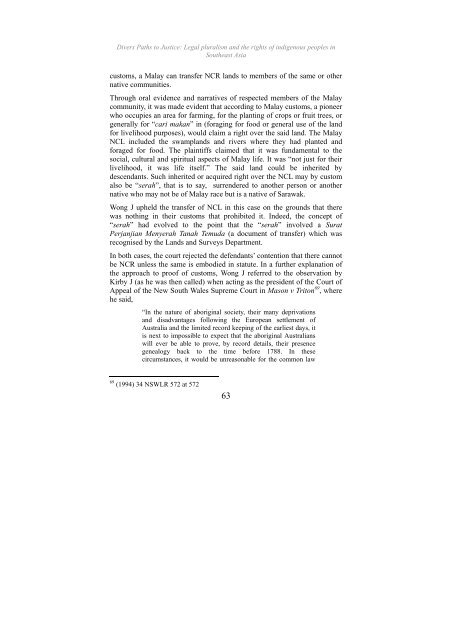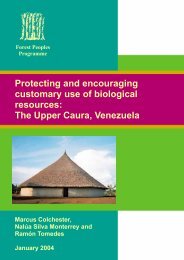Divers Paths to Justice - English - Forest Peoples Programme
Divers Paths to Justice - English - Forest Peoples Programme
Divers Paths to Justice - English - Forest Peoples Programme
Create successful ePaper yourself
Turn your PDF publications into a flip-book with our unique Google optimized e-Paper software.
<strong>Divers</strong> <strong>Paths</strong> <strong>to</strong> <strong>Justice</strong>: Legal pluralism and the rights of indigenous peoples inSoutheast Asiacus<strong>to</strong>ms, a Malay can transfer NCR lands <strong>to</strong> members of the same or othernative communities.Through oral evidence and narratives of respected members of the Malaycommunity, it was made evident that according <strong>to</strong> Malay cus<strong>to</strong>ms, a pioneerwho occupies an area for farming, for the planting of crops or fruit trees, orgenerally for “cari makan” in (foraging for food or general use of the landfor livelihood purposes), would claim a right over the said land. The MalayNCL included the swamplands and rivers where they had planted andforaged for food. The plaintiffs claimed that it was fundamental <strong>to</strong> thesocial, cultural and spiritual aspects of Malay life. It was “not just for theirlivelihood, it was life itself.” The said land could be inherited bydescendants. Such inherited or acquired right over the NCL may by cus<strong>to</strong>malso be “serah”, that is <strong>to</strong> say, surrendered <strong>to</strong> another person or anothernative who may not be of Malay race but is a native of Sarawak.Wong J upheld the transfer of NCL in this case on the grounds that therewas nothing in their cus<strong>to</strong>ms that prohibited it. Indeed, the concept of“serah” had evolved <strong>to</strong> the point that the “serah” involved a SuratPerjanjian Menyerah Tanah Temuda (a document of transfer) which wasrecognised by the Lands and Surveys Department.In both cases, the court rejected the defendants’ contention that there cannotbe NCR unless the same is embodied in statute. In a further explanation ofthe approach <strong>to</strong> proof of cus<strong>to</strong>ms, Wong J referred <strong>to</strong> the observation byKirby J (as he was then called) when acting as the president of the Court ofAppeal of the New South Wales Supreme Court in Mason v Tri<strong>to</strong>n 69 , wherehe said,“In the nature of aboriginal society, their many deprivationsand disadvantages following the European settlement ofAustralia and the limited record keeping of the earliest days, itis next <strong>to</strong> impossible <strong>to</strong> expect that the aboriginal Australianswill ever be able <strong>to</strong> prove, by record details, their presencegenealogy back <strong>to</strong> the time before 1788. In thesecircumstances, it would be unreasonable for the common law69 (1994) 34 NSWLR 572 at 57263
















